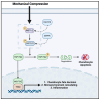Interplay of Glucose Metabolism and Hippo Pathway in Chondrocytes: Pathophysiology and Therapeutic Targets
- PMID: 39451348
- PMCID: PMC11505586
- DOI: 10.3390/bioengineering11100972
Interplay of Glucose Metabolism and Hippo Pathway in Chondrocytes: Pathophysiology and Therapeutic Targets
Abstract
In this review, we explore the intricate relationship between glucose metabolism and mechanotransduction pathways, with a specific focus on the role of the Hippo signaling pathway in chondrocyte pathophysiology. Glucose metabolism is a vital element in maintaining proper chondrocyte function, but it has also been implicated in the pathogenesis of osteoarthritis (OA) via the induction of pro-inflammatory signaling pathways and the establishment of an intracellular environment conducive to OA. Alternatively, mechanotransduction pathways such as the Hippo pathway possess the capacity to respond to mechanical stimuli and have an integral role in maintaining chondrocyte homeostasis. However, these mechanotransduction pathways can be dysregulated and potentially contribute to the progression of OA. We discussed how alterations in glucose levels may modulate the Hippo pathway components via a variety of mechanisms. Characterizing the interaction between glucose metabolism and the Hippo pathway highlights the necessity of balancing both metabolic and mechanical signaling to maintain chondrocyte health and optimal functionality. Furthermore, this review demonstrates the scarcity of the literature on the relationship between glucose metabolism and mechanotransduction and provides a summary of current research dedicated to this specific area of study. Ultimately, increased research into this topic may elucidate novel mechanisms and relationships integrating mechanotransduction and glucose metabolism. Through this review we hope to inspire future research into this topic to develop innovative treatments for addressing the clinical challenges of OA.
Keywords: OA therapeutics; chondrocyte; glucose; mechanotransduction; metabolism; osteoarthritis.
Conflict of interest statement
The authors declare no conflict of interest.
Figures



Similar articles
-
The metabolic characteristics and changes of chondrocytes in vivo and in vitro in osteoarthritis.Front Endocrinol (Lausanne). 2024 May 24;15:1393550. doi: 10.3389/fendo.2024.1393550. eCollection 2024. Front Endocrinol (Lausanne). 2024. PMID: 38854686 Free PMC article. Review.
-
The interplay between biochemical mediators and mechanotransduction in chondrocytes: Unravelling the differential responses in primary knee osteoarthritis.Phys Life Rev. 2024 Mar;48:205-221. doi: 10.1016/j.plrev.2024.02.003. Epub 2024 Feb 12. Phys Life Rev. 2024. PMID: 38377727 Review.
-
Calcium/calmodulin-dependent protein kinase II in human articular chondrocytes.Biorheology. 2006;43(3,4):223-33. Biorheology. 2006. PMID: 16912396
-
The role of metabolism in chondrocyte dysfunction and the progression of osteoarthritis.Ageing Res Rev. 2021 Mar;66:101249. doi: 10.1016/j.arr.2020.101249. Epub 2020 Dec 29. Ageing Res Rev. 2021. PMID: 33383189 Review.
-
Based on PI3K/Akt Signaling Pathway, the Effects of Gubi Decoction on Chondrocyte Proliferation, Apoptosis, and Expression of Inflammatory Factors in a Rat Model of Osteoarthritis.Altern Ther Health Med. 2024 Jul 19:AT10487. Online ahead of print. Altern Ther Health Med. 2024. PMID: 39038323
References
Publication types
Grants and funding
LinkOut - more resources
Full Text Sources

